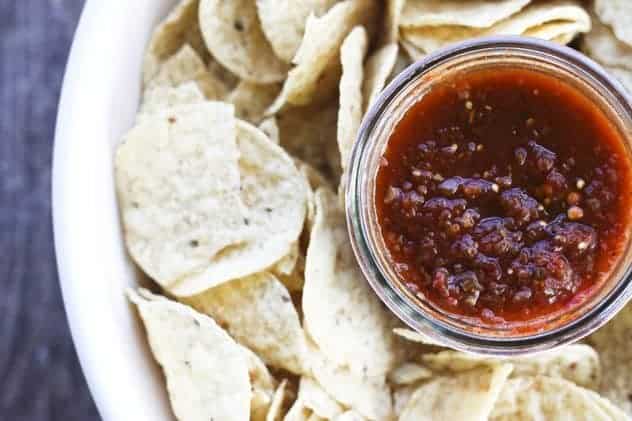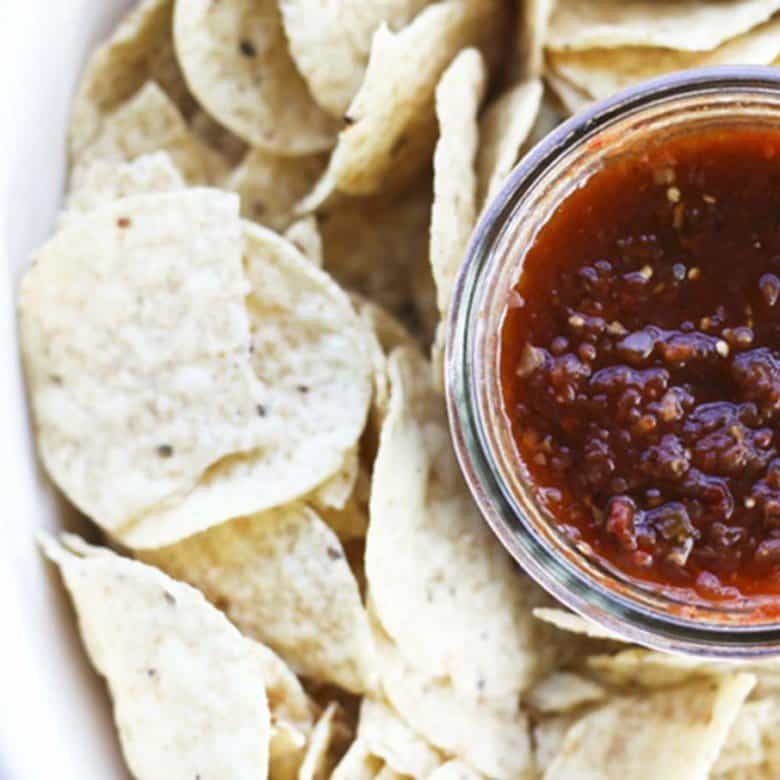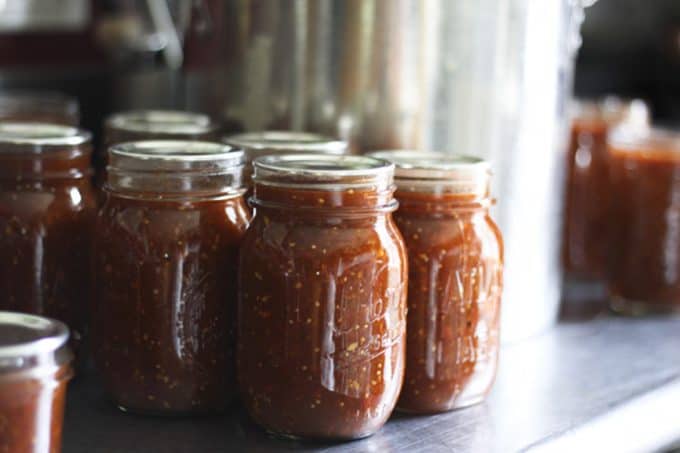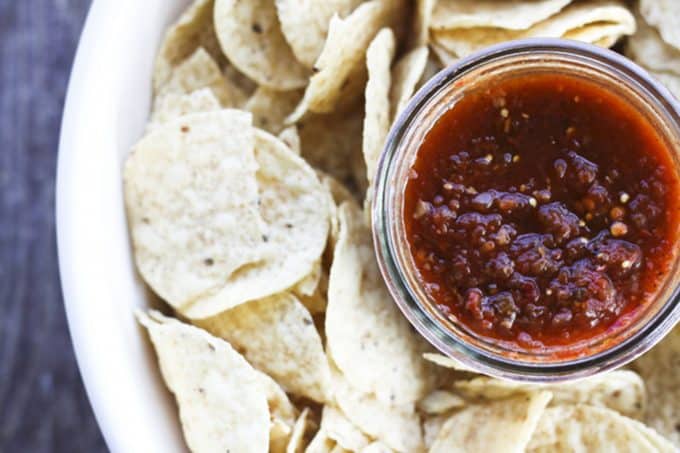This Smoky Roasted Salsa is the little black dress of the salsa world; non-traditional, smoky, fine-textured, and slightly spicy with a bold flavour that’ll knock you out, this salsa is equally wonderful when dunked with chips, poured over meats in a slow-cooker, or spooned and baked on enchiladas. I have yet to find a commercially available salsa that matches this for depth, complexity, and utter fabulousness. I make this salsa in bulk -to the tune of a bushel each of tomatillos and plum tomatoes- every summer because the boys and their friends alike act neglected and depressed if we run out before summer rolls around. While it is far and away best when prepared in season, you can make it year ‘round in a salsa emergency. Believe me when I tell you if you run out, it will be a salsa emergency.
Are you ready for some salsa? It’s a salsa time of year, after all. Now is the time for all good tomatoes to come to the aid of the salsa. Salsasalsasalsasalsasalsasalsasalsasalsa!
Clapclap. Clap. Clap. Clap. Clapclap. Clap. Clap. Clap. Ahem. That’s a salsa beat. Trust me.
It’s not that I get carried away over salsa in general, but I do over Smoky Roasted Salsa. Aside from fresh salsa (pico de gallo, or whathaveyou) this is what every single little salsa wants to be when it grows up. It’s smoky, thick, brick-red, and vibrant with guajillo and chipotle chiles, roasted tomatoes and tomatillos, and garlic that you forget you’re eating a jarred salsa. This is the salsa that makes people stop and say, “WOW!” and “Where’d you get this?” That, my friends, is no time for humility. Show them the rows of this on your shelves and puff your chest out a bit and say, “I made it.” I’d advise you fix a dollar amount in your head before serving to company, though, because you will inevitably be asked by reasonable people how much you would charge for a jar of Smoky Roasted Salsa.
Unreasonable people, or younger siblings, however, will ask, beg and plead for you to give them a jar for free and remind you of the fact that they never told mom that you made them wear your fluffy pink nightgown in exchange for playing Hot Wheels and Matchbox cars with them even though they still don’t know you would’ve played it anyway because you liked them better than Barbies anyway.
It is best to be prepared is my point.
Back to the salsa. There are a few key points that differentiate this salsa from your average chunky jarred stuff.
Cook’s Notes
- Be sure to use dried, reconstituted chiles instead of fresh ones or powdered ones. For some reason this just feels so much easier. Am I crazy? Maybe. But this is what my brain says and I’m listening.
- If your dried peppers are questionable in age, use a damp paper towel to wipe them clean before toasting. This will help remove any dust that is clinging to the outside of the chiles.
- Be sure to use a rimmed baking sheet for roasting your tomatoes, tomatillos, onions, and garlic. This will keep the juices that they inevitably give off as they roast. Be sure to add those accumulated juices to the food processor when you pulse the goodies. No juice left behind!
- Use care when handling and cutting the roasted onions and garlic. They stay hot on the inside far longer than you might think and are a little slippery. You don’t need to have perfectly cut onions and garlic since they will be pulsed in the food processor.
- When you pulse the tomatoes in the food processor or blender, you can stop as chunky or make it as smooth as you’d like. We prefer a smoother texture in this salsa and take it almost all the way to perfectly smooth with just a few bits of recognizable tomato. That makes the texture more of a thick sauce, but that is how we like it.
- Super fresh tomatoes can contain a great deal of naturally occurring pectin. It isn’t always an issue, but what this means practically is that your salsa may be quite a bit thicker in the jar after sitting on the shelf than it was when you put it into the jar. No worries. It is still good to eat. It’s just that pesky pectin butting in where it isn’t wanted. Just break it up a bit with a fork before serving and it will be liquid.
- Be sure to pick tomatillos that are ripe. You can tell this by looking at the papery husk, it should be split in a couple of places. If the fruit is green-ish, it will have the most flavour. Yellow and purple ones will be sweeter and more mild.
- Smoky Roasted Salsa is a “ground” salsa. Instead of uniformly (and angrily, depending on how much salsa you’re making and how many times you’re interrupted by the people who will eventually eat this salsa) hand chopping all the prepared ingredients, you toss them into the food processor and pulse until all the contents have been chopped to the point where they’re pretty darned little. Almost (but not quite) smooth. Why? Well, because I can. And because it tastes great. And because my kids like it better that way. And because it makes this end product more versatile. You can dump a jar on a pork or beef roast or a whole chicken, marinate it overnight, then drop it in the crockpot the next day on low. After several hours, shred everything together for the ultimate in simple main dishes. Eat the meat on sandwiches, on barbecue pizzas, in quesadillas, in this glorious dish, or on tacos. I guarantee you’ll come up with many more ways to use meat cooked in this salsa.
- I have one final piece of advice about Smoky Roasted Salsa. Double the recipe. You really should just trust me on this or one of two things will happen to you. You will find yourself crying over your last jar of salsa between bites ~OR~ you will be reduced to guarding your stash jealously, suspiciously staring down anyone walking past your pantry or basement stairs and menacingly slapping a wooden spoon against your palm to show them you mean business. It will be easier on your mind in the long run if you just go ahead and double it. You’ve been warned.
Use this to make Smoky Roasted Salsa
- sheet pan
- THIS food processor
- stainless steel pot
- long handled spoon
- ladle
- water bath canner
- pint jars

Smoky Roasted Salsa
Rate RecipeReprinted from "Not Your Mama's Canning Book"
Ingredients
- 12 dried chipotle peppers stems and seeds removed
- 12 dried guajilllo peppers stems and seeds removed
- 2 cups boiling water
- 2 small to medium sized onions
- 1 head garlic separated into cloves but not peeled
- 2 lbs plum or Roma tomatoes
- 2 lbs tomatillos husks removed
- 1 cup bottled lime juice
- 1 tablespoon honey agave, or raw sugar
- 1 1/2 teaspoons kosher salt
Instructions
- In a heavy, dry skillet (cast iron, for example) toast the chiles in batches until pliable. Place in a stainless steel or glass bowl. Pour boiling water over the chiles and weigh down with a plate or weight. Let soak for 20 minutes.
- Meanwhile, place the tomatillos, tomatoes, onions, and garlic on a half sheet pan under the broiler. Turn all of them occasionally until blistered all over and blackened in places.
- Transfer the tomatillos to a blender or food processor. Pulse until smooth: add to a large stockpot. Transfer the onions and garlic to a cutting board. Leave the tomatoes in the half sheet pan and cover with a second, inverted sheet pan or with plastic wrap to allow it to cool.
- While the tomatoes cool, peel and roughly chop the onions and garlic. Add them to the blender or food processor and pulse until finely chopped or smooth. Add to the tomatillos in the stockpot.
- Add the soaked chile peppers to the blender or food processor, strain the soaking liquid through a fine mesh sieve, add the liquid to the food processor or blender, and blend on high until smooth. Add to the stockpot.
- Turn your attention to the tomatoes. The skins should peel easily from the tomatoes. Discard the skins and add the tomatoes and juice to the blender. Pulse until the tomatoes are your desired texture. (See Cook’s Notes)
- Add to the stockpot with the lime juice, honey, sugar, or agave, and salt. Bring to a boil, stirring frequently to prevent scorching. Lower heat to medium, and simmer for 15 minutes or until slightly less thick than ketchup. Ladle into prepared pint or half pint jars to within 1/2-inch of the rim. Fix jar lids in place and tighten appropriately.
- Use canning tongs to transfer jars to a boiling water canner with boiling water to cover by 2 inches. Put the canner lid in place and bring to a full rolling boil. Boil for 15 minutes. Transfer jars to a wire rack or towel lined counter. Cool completely (at least 12 hours) before removing rings, wiping clean, and labeling. Store in a cool, dark place for up to a year.
Nutritional information is an estimate and provided to you as a courtesy. You should calculate the nutritional information with the actual ingredients used in your recipe using your preferred nutrition calculator.
did you make this recipe?
Make sure to tag @foodiewithfam on Instagram and #hashtag it #foodiewithfamily so I can check it out!
This post was originally published September 14, 2011. Updated September 2017 with improved cook’s notes, tools, and the refined, adapted recipe as it appeared in Not Your Mama’s Canning Book.







Reader's Thoughts...
Merv says
Nice idea if you are a vinegar lover, ’cause that’s all I can taste, are you sure it was not 1 TEASPOON rather than 1 CUP? No point in using anything acidic if your homegrown tomatoes and tomatillos are tangy. Obviously the added acid is a safety precaution for the hot water bath canning method. Very disappointed and trying to save by adding volumes of garden produce.
Rebecca says
Merv- That added acid is non-negotiable from a food safety standpoint. Unless you have a ph meter to test the actual acidity of your tomatoes and tomatillos (tasting tangy is not a quantifiable result) then I don’t advise adding volumes of garden produce unless you plan on freezing instead of canning your salsa. As to the taste, we all love it, so I’m afraid this is an agree to disagree moment.
Bill says
Absolutely fantastic! I’ve made two batches now…doubled each time and was out of both in days after taking a couple of jars to friends at work who shared. I absolutely LOVE this recipe and so easy. good sAlsa is crazy expensive and this is so cheap to make. I can’t thank you enough
Sarah says
I make salsas allll the time, mostly just recipes I’ve learned in Mexico and memorize without measuring, but I really wanted to make a salsa as delicious as the one at cantina Laredo but it just never came out the same. Anyways I decided to try this recipe , and is it just me or is this way to much vinegar? I used 1c of WF organic apple cider vinegar, any ideas what went wrong or how to fix without wasting the whole batch? I have high hopes for this recipe!! Thanks!
Connie says
This salsa turned out great! I made the recipe as shown and did not double. I got 5 pint jars. As far as the heat, when I took the stem off the guajillo peppers, I shook out the loose seeds. What was left in the pepper made the heat just right. You want all 12 peppers to get the Cantina Laredo taste. Thanks for sharing and for the helpful tips.
Kricket says
I really want to make this but need to know what size jars and how many. Thanks!
Savannagal says
How many and what size jars does this recipe make? Thank you.
Pamela says
Aww, shucks. That’s alright, though, because I made about 40 jars of it this afternoon.
Mmmmmhmmmm.
So.stinking.good.
Laurene says
Hi Pamela, thanks for the offer but I have already frozen it in small packets. On the weekend I tried combining a small amount with mild salsa and it worked great!
Laurene says
Hi, it’s me again….the salsa was waaaaaayyyy too hot and when I think about 24 chile peppers, it just didn’t seem right! I went to the Mexican Spice shop today and asked the Mexican store owner what she thought and how I might rescue the salsa. She advised one chile pepper of each type would be more than enough. She did suggest freezing it in small quantities and adding some to mild salsa. I am very disappointed as I grew the tomatillos from seed and I used organic tomatoes and my salsa is toast! Sadly, I won’t be trying this recipe again.
Rebecca says
We love it hot and recognized it for a good hot ‘un when we read the recipe in the Ball Complete Book of Home Preserving. Hooray for differences that make the world go ’round!
Erin Morgan Coulson says
Well said. I love this gracious, fact-based, and upbeat reply to a negative comment. Hopefully, your example will shine a little light and give folks some useful ideas on how to communicate with respect and ownership of the choices they make!
Rebecca says
Thanks so much, Erin!!! xoxoxo
Pamela says
Dear Laurene,
I know JUST what you should do!
Ship the salsa to meeeeeeeee!!!!!
Email me: thedaytontime@gmail.com, and I will send you my address.
I’ll PayPal you the shipping charges!!!!
Best,
Pamela
Laurene says
Never mind……never mind, I just read the preamble and found the answer to both questions!!! LOL
Laurene says
This recipe sounds soooooo good, I can’t wait to try it! Can you confirm that the recipe calls for 24 in total dried chiles? Also, if they are dried, do I toast them while still dried, or do I need to soak them first and then toast them?
Cindy says
I grew up eating Mexican food on a daily basis and to say I love salsa is an understatement. I was wondering if I could use fresh jalepenos or combination of fresh peppers in this recipe? The recipe I saw being made everyday is a simple 5 ingredients and would love to know how to can them for future use. Tomatoes, Jalepenos, Garlic, Onion and Cilantro. (oh a little salt but not too much as this will draw the water from the tomatoes. I put them all in my blender and give it a few pulses to get the desired consistency I want. I like the thin restaurant style. Local extension office tried to help me out on how to can properly by adding lemon juice or vinegar but it changed the taste completely. Do you know if a person could use Citric Acid in place of the lemon or vinegar?
Michelle says
How spicy is this salsa? There are two restaurants that have the best roasted tomato/smoky salsa (cantina laredo and mezcal grille) but they’re not spicy. What pepper do I need to remove or how do I make this un-spicy?
rachelle says
I agree. I need not spicy, like Cantina Laredo. Please someone reply.
R.M. says
Just put in pepper and give it a taste test – you can probably tell right away if it is just right.
Kristi says
I needed a burrito recipe and google sent me to thepioneerwoman.com. Her recipe required a jar of Mexican Tomato Sauce which I did not have. I looked in the pantry and grabbed a jar of “Smoky Roasted Tomatillo and Tomato Salsa” to use as a substitute. Two thumbs up!
Jeannie says
Looks amazing! Can you please let me know how much this recipe makes? What size and how many jars did you need to use? Thanks!
Veronica says
What size jars, and how many did they fill? I have a giant box of 1/2 pint mason jars just waiting for a good recipe!
JamieAnne says
This looks wonderful! I’m worried that it might be too spicy for me, but my father and husband would love it!
Theresa says
just to be clear, I can do this in a boiling water bath, right? Or do I need a pressure canner?
Rebecca says
Absolutely! This is a boiling water canner recipe, no pressure canner necessary!
Bev Weidner says
I have just died.
Like, I have just fallen over and crumbled to my death.
o.m.g. s.o. g.o.o.d.
Rebecca says
This salsa will bring you back with us. Really.
Josh says
I think guajillo and cascabel chilis are not the same. I don’t think I would substitute them equally.
http://en.wikipedia.org/wiki/Guajillo_chili
http://en.wikipedia.org/wiki/Cascabel_chili
Rebecca says
Actually, I forgot an “or” in there, but as they’re rated approximately equally on the Scoville scale, I would still substitute equally. Thanks for the wiki-links, though. I hope you get a chance to try the salsa!
Rebecca says
Oh! I forgot to give you a good source for subbing chiles… Try this one. http://www.foodsubs.com/Chiledry.html
I also got that substitution straight from the Ball Complete Book of Home Preserving. I personally use guajillos, but if you just plain can’t find them, the cascabels should do a nice job in their stead.